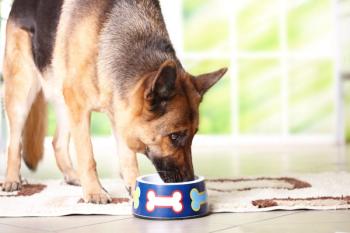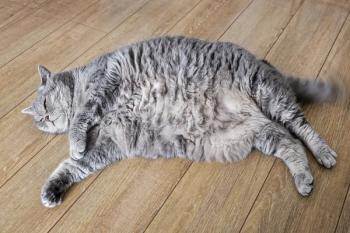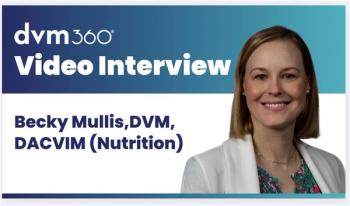
Evaluating diets for healthy pets (Proceedings)
Pets require a satisfactory diet to maintain normal structure and function at all stages of life. I define a satisfactory diet as one that is complete, balanced, palatable, digestible, and safe. Complete means that the diet provides adequate amounts of all required nutrients; balanced means that the nutrients are present in the proper proportions. Balance is crucial because excesses of some nutrients may cause deficiencies of others.
Characteristics of an adequate diet
Pets require a satisfactory diet to maintain normal structure and function at all stages of life. I define a satisfactory diet as one that is complete, balanced, palatable, digestible, and safe. Complete means that the diet provides adequate amounts of all required nutrients; balanced means that the nutrients are present in the proper proportions. Balance is crucial because excesses of some nutrients may cause deficiencies of others. The completeness and balance of a diet can be evaluated by comparing the chemical composition of the diet to the pet's nutrient requirements. Regardless of the chemical composition, the diet also must be sufficiently palatable to be eaten in quantities great enough to support normal function, and the nutrients must be digestible enough to become available to the animal. Nutrient digestibility is measured by subtracting the amount of the nutrient found in the feces from that present in the food. Even if a diet is complete, balanced, palatable and digestible, it also must be safe – containing no harmful substances. What is an appropriate diet for one life stage, however, may not be for another. Nutrient needs vary with the stage of the pet's life, with the needs for lactation and early growth being as much as four times greater than for maintenance of older, sedentary adults. Deficiencies in the nutrient content of diets often appear only during the periods of greatest nutritional stress, so it is during these times that one must be most careful to recommend the best quality diet available to the client.
Pet foods
Pet food is available in three physical forms: dry, semi-moist, and canned. Each form represents a standard method of food preservation, and each has advantages and disadvantages. Quality, however, does not depend only on physical form; good and bad examples of all forms are sold. Making direct comparisons of nutrient content among these different forms of food may be quite misleading because of the different amounts of water and energy in the three forms. For example, the amount of protein guaranteed on the label of dry cat foods is about 35%, and in canned foods about 10%. Canned foods, however, contain more water than dry foods do. For products of differing moisture content but similar energy density, a more appropriate way to compare the nutrient content is on a "dry matter" basis. To compare nutrient contents on a dry matter basis, divide the nutrient of interest by the total dry matter. Because labels provide % moisture in the food, the % dry matter is calculated by subtracting the % moisture from 100% (% dry matter = 100% - % moisture). In the above example, dry foods contain about 10% moisture, or 100% -10% moisture = 90% dry matter. Dividing 35% protein by 90% dry matter (and multiplying the result by 100) equals 38% protein on a dry matter basis. Canned foods usually contain 78% moisture, which equals 22% dry matter, so 10% protein divided by 22% dry matter equals 45% protein on a dry matter basis. Calculated on a dry matter basis, the canned food in this example contains 18% more protein than the dry food does.
Another way to compare dietary constituents is on an energy basis. This method is most useful for foods differing in fat content, because the metabolizable energy (ME) density of fat in pet foods is approximately 8.5 kcal per gram, versus 3.5 kcal/gram in carbohydrate and protein. Many commercial diets contain an overall ME density of 350 kcal/ 100 gram for dry and 100 kcal/ 100 gram for canned food as fed. To compare the foods above on an energy basis, 35 grams protein/100 grams diet divided by 350 kcal ME/100 grams diet equals 1 gram protein per 10 kcal ME for the dry diet, and 10 grams protein/100 grams diet divided by 100 kcal ME/100 grams diet equals 1 gram protein per 10 kcal ME for the canned diet as well. If we were comparing two diets of differing fat content, however, the result might have been quite different, as examination of Figure 3 will reveal. Because of differences in energy and moisture content among diets, nutrient comparisons between foods are most meaningful when made on an energy basis. Recent changes in Association of American Feed Control Officials (AAFCO) regulations permit ME estimates being added to pet food labels, but to date manufacturers have been slow to provide this information on labels. It is, however, available by calling the manufacturer or visiting their website.
Dry pet foods are predominantly extruded, expanded products. Extrusion is a process whereby dry ingredients are cooked with steam and pressure to kill microorganisms, and to increase digestibility of the ingredients. For example, starch in the mixture is partially degraded, "gelatinized", in the process, which enhances its digestibility. The heated food is then forced (extruded) through a small opening in a plate at the end of the pressure chamber. The sudden change in pressure when the food exits the chamber causes the gelatinized carbohydrate to expand. The shape of the opening in the plate can be varied to produce different shapes of the food.
Advantages of dry foods may include lower cost and greater convenience. Dry foods may be left out for the pet to "self feed" for longer periods than other forms without spoiling, although unopened packages of dry foods tend to spoil more quickly than semi-moist or canned foods in humid climates. Disadvantages of dry foods can include lower energy density, and the possibility of decreased palatability and digestibility of the dry ingredients commonly used in these formulas. The amount of available energy in some dry foods also may make it difficult for pets to eat enough food to meet calorie needs during periods of nutritional stress, such as rapid growth and lactation.
semi-moist foods are produced by similar processes as dry foods. The primary difference is that chemical preservatives are added to prevent spoilage while retaining a soft, moist character. Compounds used to preserve semi-moist foods include acids and sorbitol. Phosphoric, hydrochloric and malic acids are added to bind water, and to increase the acidity of the food to inhibit bacterial growth. Sorbitol is added to decrease fungal growth. Propylene glycol previously was added to bind water, but recent concerns about the safety of propylene glycol (which induces increases in Heinz body and reticulocyte numbers, and a decrease in erythrocyte survival in some cats have resulted in its removal from semi-moist cat foods. As with dry foods, semi-moist foods may be self-fed. They are also digestible and palatable, and, like dry and canned foods, can be formulated to include fresh animal tissue. The main disadvantage of semi-moist foods is that they may be expensive.
Canned foods also are palatable and digestible. Any type of ingredient may be used in canned foods because heat and pressure are applied to the sealed cans to ensure sterility. This method of processing also generally results in the greatest loss of nutrients, which must be compensated for in the product formulation. Two major forms of canned food are produced for pets: "ration" type diets, which are made up of animal tissue, soy and cereal grains, and "gourmet" diets which primarily are meat with vitamins and minerals added to produce a satisfactory diet. Gourmet products must be carefully formulated because muscle tissue alone is a poorly balanced, incomplete food. Animals in the wild also eat the viscera and bone of their prey, which results in a more balanced diet. Advantages and disadvantages of canned foods are similar to those of semi-moist foods, with the additional disadvantage that if they are opened and left out for prolonged periods they may spoil.
Some pet food manufacturers use what is known as "least cost formulation" to compound their diets. This means that the proportion and quality of ingredients may fluctuate with ingredient prices. The final formula at any given time thus depends on a computer program, which may or may not generate exactly the same formulation as the one actually tested during feeding trials. Although variations generally are minor, this may explain why the observant owner may note some variability from batch to batch. Manufacturers of premium pet foods commonly use fixed formulas, which do not change based on ingredient prices. This is one of the reasons for the higher price of these foods, which often are sold only by specialty pet stores. It is not clear that one of these methods is preferable to the other. Although the variation in nutrient composition is greater, with least cost formulation, changing ingredients may reduce the risk of a deficiency of a nutrient in one of the "fixed" ingredients. Moreover, animals are sufficiently resilient to changes in nutrient to survive the minor changes that occur.
If economy is a consideration, food costs should be compared on an energy basis. Cost per kcal ME is the most relevant comparison if the ME content of the food is known. If it is not listed on the food, one may contact the manufacturer for this information. A simpler way to compare the economic value of a food is to note the price and date of purchase of the food. When it all has been consumed, the price of the food divided by the number of days fed is the feeding cost per day.
Pet food labeling
Pet food labels are legal documents. Pet food labeling in the United States is based on rules established by the Association of American Feed Control Officials (AAFCO) to ensure compliance with federal and state feed regulations. Regulations that apply to pet food labeling and testing of foods for nutritional adequacy are published in the AAFCO manual. This manual, updated yearly, also provides definitions of terms. For example, AAFCO defines "complete" as "a nutritionally adequate feed for animals other than man; by specific formula is compounded to be fed as the sole ration and is capable of maintaining life and/or promoting production without any additional substance being consumed except water." "Balanced" "...a term that may be applied to a diet, ration, or feed having all the required nutrients in proper amount and proportion based upon recommendations of recognized authorities in the field of animal nutrition, such as the National Research Council, for a given set of physiological animal requirements. The species for which it is intended and the functions such as maintenance or maintenance plus production (growth, fetus, fat, milk, eggs, wool, feathers, or work) shall be specified".
Pet food labels must include the food type and product name, guaranteed analysis, ingredient content, net weight, manufacturer's or distributor's name and address, and "a claim that the pet food meets or exceeds the requirements of one or more of the recognized categories of nutritional adequacy: gestation, lactation, growth, maintenance, and complete for all life stages, as those categories are set forth in AAFCO regulations PF2(l) and (m)";unless another scientifically substantiated claim is made, the food is designated solely for intermittent or supplemental feeding, or is to be used on the advice of a veterinarian."
The "food type" means that the label must state "dog" or "cat" food, to identify the species for which it is intended. This statement is intended to help guide consumer purchase, although dogs can eat cat food, and many high protein, high fat dog foods probably are relatively safe for cats. Additionally, dogs with decreased intakes may be fed diets labeled for cats to improve nutrient intake. Many adjectives are used as part of the product name to appeal to consumers, such as "dinner, platter…". AAFCO has rules for their use:
The guaranteed analysis lists minimum amounts of crude protein and fat and maximum amounts of crude fiber and moisture present in the product. Although a legal requirement, the guaranteed analysis is of little value. The analytical methods were developed in Germany in the 19th century to evaluate ruminant animal feeds; the methods of analysis for fat and protein are nonspecific, and the crude fiber method used underestimates the indigestible fraction of the food for pets. Further, the numbers are not meant to represent the amount of nutrient present, only the minimum or maximum. More accurate analyses are often available on written request from manufacturers.
A list of ingredients must also be present on the label. Some ingredients listed on commonly purchased pet foods in the United States and their functions in the diet are described below:
Listed ingredients fall into four major categories: water, energy sources, protein sources, and vitamins and minerals added to balance the food. Ingredient names have specific legal definitions, which are also presented in the AAFCO manual. The definitions are somewhat imprecise to allow for normal variation in feedstuffs and processing procedures. AAFCO also requires that ingredients be listed "in descending order by their predominance by weight". "Descending order" must be evaluated carefully, however, because ingredient lists can be misleading. For example, a meat protein source followed on the list by two or three grain sources may indicate that grain, not meat, is the primary ingredient. This is especially true if the adjective "fresh" is used to describe the meat, because it means that the meat contains its natural water content, which often is removed during processing. Moreover, there is no way to know what quality grade of the ingredient was used, which could affect nutritional adequacy.
The net weight is the amount of food in the container, often in pounds and grams. As mentioned, it may give a rough estimate of the energy density of canned foods, many of which contain about 1 kcal/gram as fed. One reason to read the net weight when comparing foods is that manufacturers sometimes reduce the size of containers without changing the price. For example, what many think of as a "16 oz." can is really 13.2 oz., and a "6 oz." can really may be 5.5 oz.
The manufacturer or distributor's must provide their name and address on the label to identify the source of the product, and permit the consumer or other interested person to contact the producer of the food. Many commercial foods also provide a toll-free telephone number or website, which may provide information concerning the food.
A claim of "complete and balanced" also must appear on the label. This claim may be met in any of three ways. The first is by calculation. If a manufacturer can calculate that the combination of ingredients used "meets or exceeds" NRC recommended levels from published nutrient composition tables, the claim may be made on this basis. The second method is by analysis of the diet. If chemical analysis shows that the food contains levels of nutrients that exceed the NRC recommended minimums, it also may claim nutritional adequacy. Unfortunately, these methods are of very little practical value in the veterinary evaluation of pet foods. The analytical profile of many pet food ingredients is too variable for "book values" to be useful, and provides no measure of nutrient availability. Moreover, nutrient excesses or unmeasured toxic substances could be present, and one could not know if pets would eat the food. The third, and best, method of establishing a nutritional claim is by "protocol testing". These tests require the food to be fed to pets during the period, often gestation, lactation and growth, for which the claim is made. AAFCO label guarantees do not require retesting. Despite this limitation, feeding tests currently are the most valid way to ensure that the food can actually meet the nutritional needs of pets to which it is fed. Despite the required amount of information, evaluation of the label may not be sufficient to predict the quality or price of the food.
A relatively recent label development is the presence of so-called descriptive terms. Recently, terms "light," "lean," "low," or "reduced" calorie or fat have been approved by AAFCO to appear on pet food labels. The term refers to energy density in kcal/kilogram diet, calibrated by the % moisture. The definitions for dog and cat foods are presented in the table below.
These terms permit manufacturers to draw attention to foods with reduced calorie and fat content. Unfortunately, as is the case with human foods, these terms ignore the fact that energy and fat intake are feeding issues rather than diet issues. The increase in "low-fat" human foods during the last two decades of the 20th century has been associated with a relentless increase in the number of obese humans. Thus, unless food intake is controlled, the nutrient density of the diet cannot moderate body condition, seductive as the promise might be.
Similarly, terms such as "promotes urinary tract health" on commercial cat food labels have little veterinary value. This expression, coined in the 1980's, was intended to convey the diet's formulation to reduce the risk of struvite urolithiasis. The subsequent increase in the prevalence of calcium oxalate urolithiasis, and the recognition that struvite urolithiasis is not a common cause of signs of lower urinary tract disease, makes this term of limited and questionable descriptive value.
Newsletter
From exam room tips to practice management insights, get trusted veterinary news delivered straight to your inbox—subscribe to dvm360.






